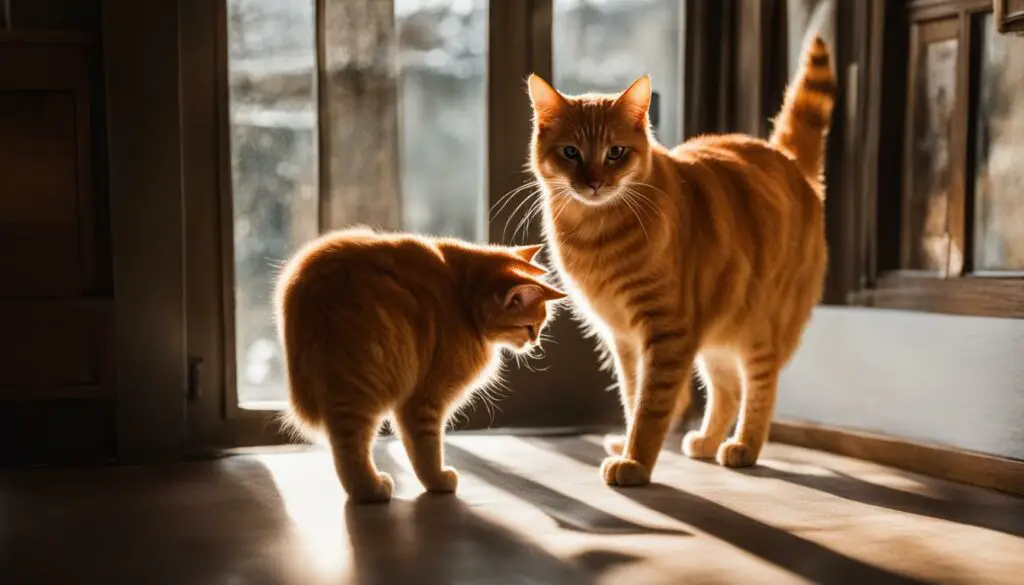Taming an aggressive cat may seem like a daunting task, but with the right approach and techniques, it is possible to transform them into a well-behaved and calm companion. Understanding the causes of aggression and effectively communicating with your feline friend are key factors in successfully taming an aggressive cat.
Key Takeaways:
- Recognize the signs of aggression in cats, such as hissing, growling, and swatting.
- Understand that cats act out of fear, insecurity, territoriality, or pain, not revenge.
- Manage separation anxiety by creating a comforting environment and maintaining a regular schedule.
- Provide extra love and attention to help your cat cope with grief and loss.
- Desensitize your cat to the sound of a vacuum cleaner gradually and with positive reinforcement.
Recognizing Body Language and Behavior
Understanding a cat’s body language is crucial for recognizing signs of aggression. Cats communicate through various behaviors and gestures, which can indicate their mood and intentions. By accurately interpreting your cat’s body language, you can gain valuable insights into their emotions and prevent potential aggressive episodes.
Here are some common signs of aggression in cats:
- Hissing: A cat may hiss when feeling threatened or cornered.
- Growling: Growling can be a warning sign of aggression, indicating that the cat is prepared to defend itself.
- Swatting: Cats may swat at objects or people when agitated, displaying their readiness to attack.
- Lunging: This aggressive behavior involves the cat forcefully moving forward, often accompanied by bared teeth and claws.
It’s important to be vigilant and observant of any changes in your cat’s behavior. If you notice recurrent signs of aggression, it is advisable to consult a veterinarian for further evaluation and guidance. They can help determine the underlying cause of the aggression and recommend appropriate intervention strategies.

Interpreting Cat’s Body Language:
Understanding the subtleties of cat body language can help you differentiate between defensive behaviors and signs of aggression. Here are a few examples:
“When a cat arches its back and has an erect tail, it may be expressing fear or aggression. However, if the tail is puffed up, usually accompanied by an arched back and hissing, it is a clear indication of aggression.”
Additionally, a cat’s flattened ears, dilated pupils, and exposed teeth are all visual cues of potential aggression. It’s essential to pay attention to these subtle signals and respond accordingly to prevent escalating aggression.
Creating a Safe and Calm Environment
Providing a safe and comfortable environment is key to reducing aggression in cats. Cats need a designated space where they can retreat and feel secure. It’s beneficial to offer hiding spots, such as cat condos or elevated shelves, along with cozy resting areas.
Furthermore, ensuring a consistent routine and minimizing stressors can contribute to a calmer environment. Cats thrive on predictability, so maintaining a regular feeding schedule and playtime can help reduce anxiety and decrease the likelihood of aggressive behavior.
| Signs of Aggression | Body Language |
|---|---|
| Hissing | Ears flattened, arched back, hissing sounds |
| Growling | Low growling sounds, bared teeth |
| Swatting | Quick swipes with extended claws |
| Lunging | Forceful forward movement, bared teeth and claws |
Recognizing these signs and body language can help cat owners create a safe and harmonious environment for their feline companions.
By understanding and interpreting a cat’s body language, you can effectively respond to their needs and prevent aggression. Creating a safe and comfortable environment, along with maintaining consistent routines, plays a vital role in reducing stress and promoting overall well-being for your cat.
Understanding Cat Motivations
When dealing with an aggressive cat, it is essential to understand the motivations behind their behavior. Contrary to popular belief, cats do not act out of revenge. Their aggressive actions are driven by different instincts and emotions than those of humans. By understanding these motivations, we can address the underlying causes of aggression and work towards taming an aggressive cat.
Cats may display aggression due to various reasons, such as fear, insecurity, territoriality, or pain. It is important to recognize that their aggressive behavior is often a response to feeling threatened or uncomfortable. For example, if a cat feels scared or cornered, they may exhibit aggressive behaviors as a way to protect themselves.
Addressing the underlying cause of aggression is crucial in taming an aggressive cat. Whether it’s providing a safe and secure environment, addressing any pain or discomfort, or helping them feel more confident, understanding their motivations allows us to tailor our approach and provide the necessary support. By addressing these underlying issues, we can help our cats feel more secure, confident, and ultimately reduce their aggressive tendencies.
Addressing Fear and Insecurity:
Many cats exhibit aggression due to fear and insecurity. Creating a safe and comfortable environment for them can go a long way in reducing aggression. Providing hiding spots, vertical spaces, and calming pheromone diffusers can help create a sense of security. Additionally, using positive reinforcement techniques, such as rewards and treats, can help build their confidence and create positive associations with previously fear-inducing situations. It’s important to be patient and consistent in addressing their fear and insecurity, gradually helping them overcome these issues.
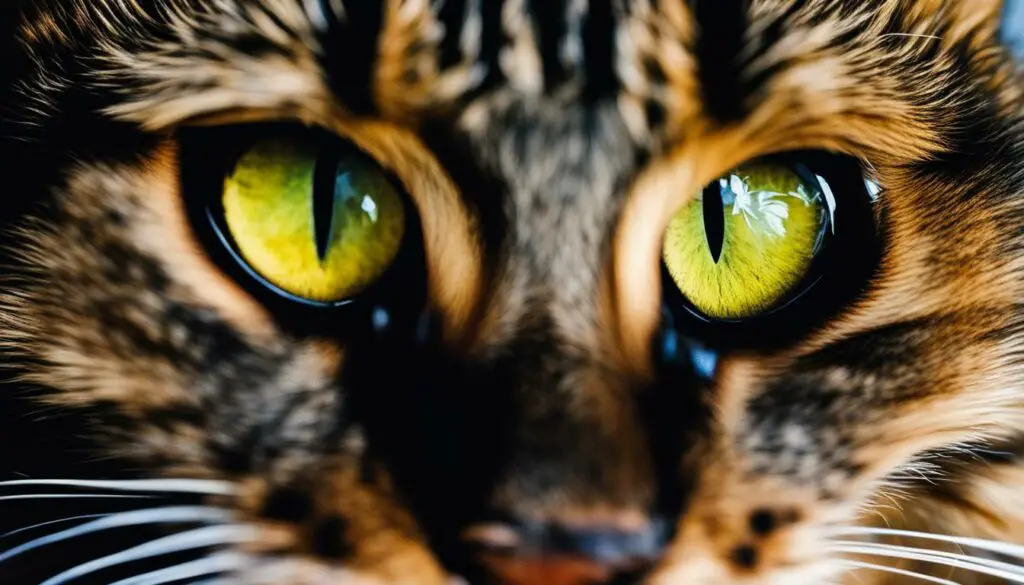
Managing Territorial Aggression:
Cats are inherently territorial animals, and aggression can arise when they feel their territory is being invaded. Providing individual areas and resources for each cat, such as separate feeding stations and litter boxes, can help prevent territorial conflicts. Additionally, using positive reinforcement to reward calm behavior and redirecting aggressive actions towards appropriate outlets, such as interactive toys or scratching posts, can help channel their territorial instincts in a healthier way.
Dealing with Pain and Discomfort:
Pain and discomfort can also contribute to aggressive behavior in cats. Regular veterinary check-ups are crucial in identifying and addressing any underlying health issues that may be causing pain. Providing comfortable resting areas, especially for older cats with joint issues, and ensuring easy access to food, water, and litter boxes can help alleviate any physical discomfort. By addressing their pain and discomfort, we can reduce their stress levels and the likelihood of aggressive behavior.
Understanding cat motivations is a key aspect of successfully taming an aggressive cat. By addressing their fear, insecurity, territoriality, and pain, we can provide the necessary support to help them feel safe, secure, and ultimately reduce their aggressive tendencies. It is important to approach their behavior with empathy, patience, and consistency, and seek professional advice if needed.
Managing Separation Anxiety
Separation anxiety is a common issue among cats, and it can often result in aggressive behavior. When cats feel anxious or stressed due to their owners’ absence, they may resort to acting out aggressively as a way to cope with their emotions. As a cat owner, it is important to take steps to manage separation anxiety and help your feline friend feel more secure and calm.
To alleviate separation anxiety in cats, create a comforting environment by providing familiar items that carry your scent. Leave a piece of clothing or a blanket with your scent on it in the cat’s designated resting area. This will help them feel close to you even when you’re not around. Additionally, maintaining a regular schedule for feeding, playtime, and other activities can provide a sense of predictability and reduce anxiety.
Behavioral techniques can also be effective in managing separation anxiety. Consider using a pheromone diffuser, such as Feliway, which releases synthetic feline facial pheromones that help create a calming atmosphere. These diffusers can be plugged into electrical outlets around the house to promote a sense of security and reduce anxiety-related aggression.
| Ways to Manage Cat Anxiety |
|---|
| Provide a comforting environment with familiar scents |
| Maintain a regular schedule for feeding and activities |
| Use a pheromone diffuser to create a calming atmosphere |
| Provide interactive toys and distractions |
In addition to creating a calming environment, it is essential to provide interactive toys and distractions for your cat. Engaging their senses and keeping them mentally and physically stimulated can help redirect their energy and alleviate anxiety. Puzzle toys, treat-dispensing toys, and interactive play sessions can all help keep your cat engaged and provide a healthy outlet for their emotions.
If your cat’s separation anxiety and aggression persist despite your efforts, consult with a veterinarian or a professional cat behaviorist. They can provide additional guidance and tailor a management plan specific to your cat’s needs. Remember, patience and consistency are key when managing separation anxiety in cats, and with time and the right approach, you can help your feline companion feel more comfortable and secure.
Dealing with Grief in Cats
Cats are known for their independent nature, but they can also experience grief and mourning when they lose a companion. It is important to recognize the signs of grief in cats and provide them with the support they need during this difficult time.
When a cat is grieving, they may exhibit changes in behavior such as loss of appetite, increased vocalization, or seeking extra attention. It’s crucial to be patient and understanding during this period, offering them extra love and attention to help them cope with their loss.
“Grief is a natural response for cats when they lose a companion,” says Dr. Jane Thompson, a veterinarian specializing in feline behavior. “They may go through a mourning period and may even show signs of depression. It’s important to provide them with a comforting and familiar environment to help them through this difficult time.”
Creating a safe and consistent environment for your grieving cat can help them feel more secure. Keep their daily routine as normal as possible and provide familiar items, such as bedding or toys, that carry the scent of their lost companion. These familiar smells can bring them comfort and help ease their grief.
| Grief Signs in Cats | Ways to Help Cats Grieve |
|---|---|
| Loss of appetite | Offer tasty, highly palatable foods to encourage eating |
| Increased vocalization | Provide extra attention and reassurance |
| Withdrawal or hiding | Create safe and cozy hiding spots |
| Restlessness or pacing | Engage in interactive play sessions to distract and channel their energy |
| Seeking extra attention | Be responsive to their needs and spend quality time together |
It’s important to remember that each cat’s grieving process is unique, and it may take time for them to overcome their loss. If you’re concerned about your cat’s behavior or well-being, consult with a veterinarian who specializes in feline behavior for guidance and support.

Helping Cats Through the Grieving Process
Understanding the grieving process and providing a compassionate and nurturing environment can help your cat navigate through their grief. While it may be challenging to see your cat in pain, with time and support, they will be able to heal and adjust to life without their companion.
Taming Cat Fear of Vacuum Cleaners
Cats are notorious for their fear of vacuum cleaners, and this fear can often lead to aggressive behavior. If your cat becomes aggressive or anxious whenever the vacuum is turned on, it’s important to address their fear and help them overcome it. By desensitizing your cat to the sound of the vacuum and gradually associating it with positive experiences, you can help alleviate their fear and reduce their aggression.

Desensitizing Cats to Vacuum Noise
Desensitizing your cat to the noise of the vacuum involves exposing them to the sound in a controlled and gradual manner. Start by keeping your cat in a separate room while you turn on the vacuum at a very low volume. Allow your cat to observe the vacuum from a safe distance without feeling threatened. Reward your cat with treats and praise for remaining calm and relaxed during this exposure.
Over time, gradually increase the volume of the vacuum while continuing to reward your cat for their calm behavior. The goal is to help your cat associate the sound of the vacuum with positive experiences rather than fear or aggression. Consistency and patience are key during this process, as it may take several sessions for your cat to become fully comfortable with the vacuum noise.
“Desensitizing your cat to the vacuum involves patience and positive reinforcement. Rewarding your cat for remaining calm during exposure to the vacuum noise can help them associate it with positive experiences.” – Cat Behavior Expert
In addition to desensitization, providing your cat with a safe space to retreat to during vacuuming sessions can also help alleviate their fear. Set up a cozy hiding spot or a designated room where your cat can feel secure and avoid the noise and commotion. This can provide them with a sense of control and reduce their anxiety and aggressive response towards the vacuum.
By helping your cat overcome their fear of vacuum cleaners, you can create a more peaceful environment for both you and your feline companion. Remember to be patient and consistent in your approach, and consult with a veterinarian or professional behaviorist if your cat’s fear and aggression persist.
Avoiding Aggression during Playtime
Playtime is a crucial aspect of a cat’s daily routine, providing them with mental and physical stimulation. However, sometimes play sessions can escalate into aggression, leading to scratches or bites. To prevent cat play aggression, it is important to understand appropriate play behavior and implement strategies to redirect energy and maintain a safe and enjoyable playtime experience.
Recognizing the signs of play aggression
During play, cats may engage in behaviors that mimic hunting, such as pouncing, chasing, and biting. While these behaviors are normal, it is vital to differentiate between play and aggression. Signs of play aggression may include excessive biting or scratching, flattened ears, dilated pupils, and aggressive vocalizations. If you notice these signs during play, it is essential to intervene promptly and redirect your cat’s behavior.
Tips to prevent cat play aggression
- Use interactive toys: Engage your cat in interactive play using toys that mimic prey, such as feather wands or laser pointers. These toys allow your cat to fulfill their hunting instincts without directing their aggression towards you.
- Avoid using your hands: Resist the temptation to use your hands or feet as play objects. This can send mixed signals to your cat, confusing playtime boundaries and increasing the chances of play aggression.
- Set playtime limits: Cats have bursts of energy followed by periods of rest. Set designated playtimes to ensure your cat doesn’t become overstimulated or frustrated, which can lead to aggression. Observe their body language, and if they start showing signs of aggression, end the play session calmly.
- Provide outlets for energy: Cats require mental and physical stimulation throughout the day. Offer scratching posts, climbing trees, and puzzle toys to keep your cat entertained and prevent pent-up energy that could be directed towards play aggression.
Remember, playtime should be a positive and enjoyable experience for both you and your cat. By understanding the signs of play aggression and implementing appropriate play strategies, you can ensure safe and engaging play sessions that strengthen the bond between you and your feline companion.
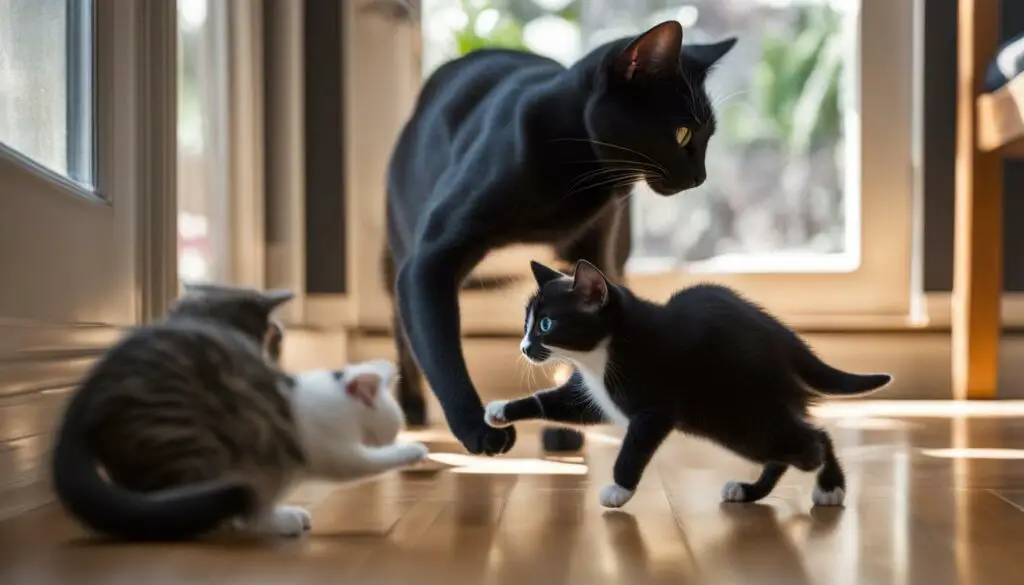
Establishing Boundaries and Communication
Setting boundaries and establishing clear communication with your cat is crucial in taming aggression. Cats are highly territorial animals, and they need to understand the limits and rules within their environment. By setting boundaries, you can create a safe and harmonious space for both you and your feline companion.
One way to set boundaries is through consistent positive reinforcement training. Reward your cat with treats or affection when they display desired behavior, such as using a scratching post instead of your furniture. This positive reinforcement reinforces boundaries and encourages your cat to repeat the behavior.
Clear communication is also essential in understanding your cat’s needs and avoiding aggressive interactions. Pay attention to their body language and vocal cues. When your cat exhibits signs of discomfort or agitation, such as flattened ears or a flicking tail, it’s important to give them space and avoid approaching or touching them. Respect their boundaries and allow them to come to you when they feel comfortable. By fostering a relationship built on trust and clear communication, you can minimize the chances of aggression.

Understanding Cat Body Language
Understanding cat body language is key to effective communication. Here are some important cues to watch for:
- Ears: When a cat’s ears are upright and forward, it often indicates a relaxed and content state. On the other hand, flattened ears can signify fear or aggression.
- Tail: A relaxed, gently swaying tail usually indicates a calm cat. A lashing or puffed-up tail may signify aggression or fear.
- Eyes: Dilated pupils may indicate excitement, fear, or aggression. Narrowed pupils, on the other hand, can be a sign of aggression or discomfort.
- Body posture: A relaxed, loose posture suggests a content cat. Crouching or tense body posture can indicate aggression or fear.
By paying attention to these cues and adapting your behavior accordingly, you can foster open and effective communication with your cat, reducing the likelihood of aggression.
Creating a Safe and Comfortable Environment
When it comes to taming an aggressive cat, creating a cat-friendly environment is essential. Providing a safe and comfortable space can help reduce stress and prevent territorial conflicts, ultimately promoting a peaceful and harmonious atmosphere in your home. Here are some tips to create a cat sanctuary:
- Offer plenty of hiding spots: Cats feel secure when they have places to retreat to. Provide cat-friendly hiding spots such as cat trees, cardboard boxes, or cozy blankets where your cat can relax and feel safe.
- Provide vertical spaces: Cats love to climb and perch high above the ground. Install cat shelves or invest in a cat tree with multiple levels to give your cat opportunities to explore and observe their surroundings.
- Invest in scratching posts: Scratching is a natural behavior for cats, and providing appropriate scratching surfaces can prevent furniture aggression. Choose sturdy scratching posts made of sisal or carpet and place them strategically throughout your home.
- Create comfortable resting areas: Cats need their own cozy spaces to rest and sleep. Provide soft bedding, such as cat beds or blankets, in quiet areas of your home where your cat can curl up and relax undisturbed.
By creating a cat-friendly environment, you are giving your cat the opportunity to express their natural behaviors and reduce their stress levels. Remember, a happy and content cat is less likely to display aggressive behaviors.

Addressing Litter Box Issues
Litter box problems can be a common source of frustration for both cat owners and their feline companions. Understanding and addressing these issues is essential in preventing litter box aggression and maintaining a harmonious living environment. By identifying the underlying causes and implementing appropriate solutions, you can help your cat feel more comfortable and confident with their litter box.
One of the most common reasons for litter box problems is improper cleanliness. Cats are naturally clean animals, and a dirty litter box can be a major deterrent for them. Ensure that you clean the litter box regularly, removing waste and replacing the litter as needed. Additionally, consider using unscented litter, as some cats may be sensitive to strong odors.
Another important factor to consider is the placement and accessibility of the litter box. Cats prefer privacy when using their litter box, so make sure it is located in a quiet and secluded area of your home. Additionally, provide multiple litter boxes in different areas of the house, especially if you have multiple cats. This can help prevent territorial conflicts and provide each cat with their own designated space.
If your cat continues to show aggression or avoidance towards the litter box, it is important to consult with a veterinarian. They can rule out any underlying medical conditions that may be causing the behavior and provide appropriate treatment. A veterinarian may also offer additional guidance on litter box training techniques and behavior modification strategies to help resolve the issue.
| Common Causes of Litter Box Problems | Solutions |
|---|---|
| Poor litter box cleanliness | Regularly clean the litter box and replace the litter as needed. Use unscented litter. |
| Inadequate litter box placement | Choose a quiet and secluded area for the litter box. Provide multiple litter boxes in different locations. |
| Underlying medical conditions | Consult with a veterinarian to rule out any medical issues and receive appropriate treatment. |
By addressing litter box issues and ensuring a clean, comfortable, and accessible environment for your cat, you can help prevent litter box aggression and promote their overall well-being. Remember to be patient and consistent in your approach, and seek professional advice if needed. With proper care and attention, you can create a positive litter box experience for your furry friend.
Redirecting Scratching Behavior
Redirecting a cat’s scratching behavior is crucial in preventing aggression towards furniture and other household items. Cats have a natural instinct to scratch, which helps them stretch, mark their territory, and keep their claws healthy. However, this behavior can sometimes cause damage to our belongings. By providing appropriate alternatives and using positive reinforcement techniques, we can redirect their scratching behavior to more suitable surfaces.
One effective method is to set up multiple scratching posts throughout your home. These posts should be tall, sturdy, and covered with materials that cats find appealing, such as sisal or cardboard. Place the posts strategically near the areas where your cat likes to scratch, such as furniture or door frames. Encourage your cat to use the scratching posts by rubbing catnip on them or attaching toys to the posts to make them more enticing.
When you catch your cat scratching furniture or other off-limits items, gently redirect their attention to the appropriate scratching post. You can use a toy or treat to lure them over to the post and praise them when they start using it. Consistency is key, so be sure to reward and reinforce the behavior every time your cat uses the designated scratching post.
| Benefits of Redirecting Scratching Behavior | How to Redirect Scratching Behavior |
|---|---|
|
|
Remember to be patient with your cat as they learn to redirect their scratching behavior. It may take some time for them to fully adjust and consistently use the appropriate surfaces. Avoid punishing your cat for scratching furniture, as this can create a negative association with scratching and lead to more aggression. Instead, focus on positive reinforcement and providing appealing alternatives. With consistency and patience, you can successfully redirect your cat’s scratching behavior and prevent furniture aggression.
Different Types of Scratching Posts
There are various types of scratching posts available that cater to different cats’ preferences. Some cats may prefer tall posts they can stretch on, while others may prefer horizontal surfaces. Experiment with different options to find what works best for your cat. Here are a few examples:
- Tall vertical posts: These posts allow cats to fully stretch their bodies while scratching. They are often covered in sisal, which provides a satisfying texture for cats.
- Horizontal scratching pads: These pads lie flat on the ground and are ideal for cats who prefer scratching in a horizontal position. They are usually made of cardboard or rough fabric.
- Scratching trees or condos: These larger structures combine scratching surfaces with platforms for climbing and perching. They offer a variety of scratching angles and can be especially appealing to active cats.
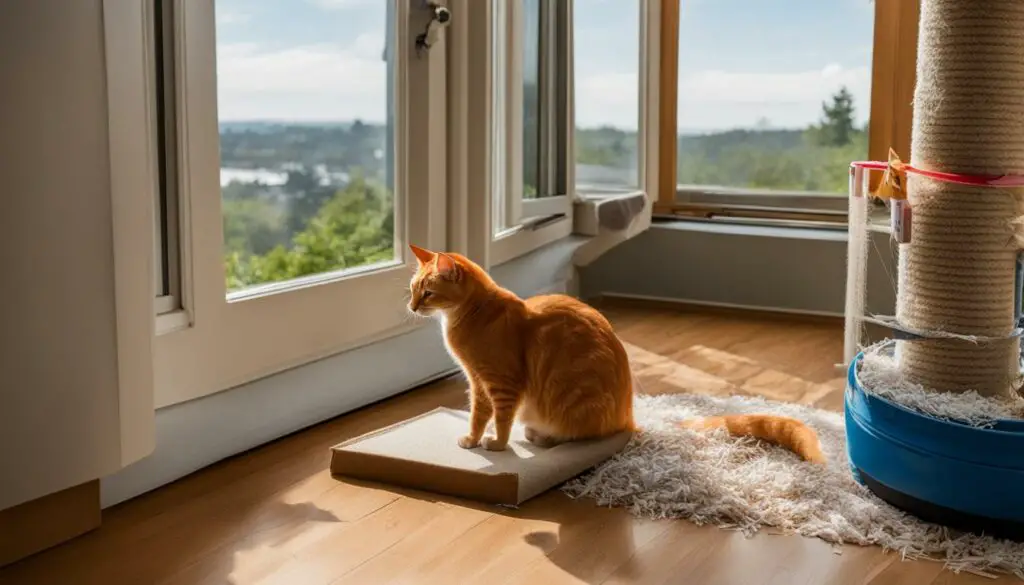
Training and Socializing an Aggressive Cat
Training and socializing an aggressive cat requires patience, consistency, and understanding. By using positive reinforcement techniques and gradual exposure to social interactions, you can help your cat develop alternative behaviors and become more comfortable in various situations.
One effective training method is clicker training, which involves using a clicker device to signal desired behavior and rewarding the cat immediately after. This helps the cat associate the clicker sound with positive experiences and encourages them to repeat the behavior. For example, if your cat tends to lash out when approached by strangers, you can use the clicker to reward calm and friendly behavior whenever someone new is around.
It’s important to introduce socialization gradually and in controlled environments. Start by exposing your cat to one person or animal at a time, allowing them to become familiar with each other’s scents before any direct contact. Provide plenty of positive reinforcement, such as treats and praise, when your cat demonstrates calm and non-aggressive behavior during these interactions. Gradually increase the duration and intensity of the socialization sessions as your cat becomes more comfortable.
Additionally, creating a cat-friendly environment can aid in the training and socialization process. Provide your cat with plenty of vertical spaces, such as cat trees or shelves, where they can observe their surroundings from a safe distance. Offer interactive toys and engage in play sessions that encourage positive behavior. Having a predictable daily routine can also help your cat feel more secure and reduce their overall anxiety levels.
Remember, every cat is unique, and the training process may take time. Be patient and consistent, and always prioritize your cat’s safety and well-being. Consult with a veterinarian or professional cat behaviorist for personalized guidance and support in training and socializing your aggressive cat.
Table: Training and Socialization Tips
| Tip | Description |
|---|---|
| Reward-based training | Use positive reinforcement techniques, such as clicker training, to reward desired behaviors and discourage aggression. |
| Gradual socialization | Introduce your cat to new people and animals gradually and in controlled environments to help them become more comfortable. |
| Provide vertical spaces | Give your cat access to vertical spaces, like cat trees, to allow them to observe their surroundings and feel more secure. |
| Engage in interactive play | Use interactive toys and play sessions to redirect your cat’s energy and encourage positive behavior. |
| Maintain a routine | Establish a predictable daily routine for feeding, playtime, and rest to help your cat feel more secure. |
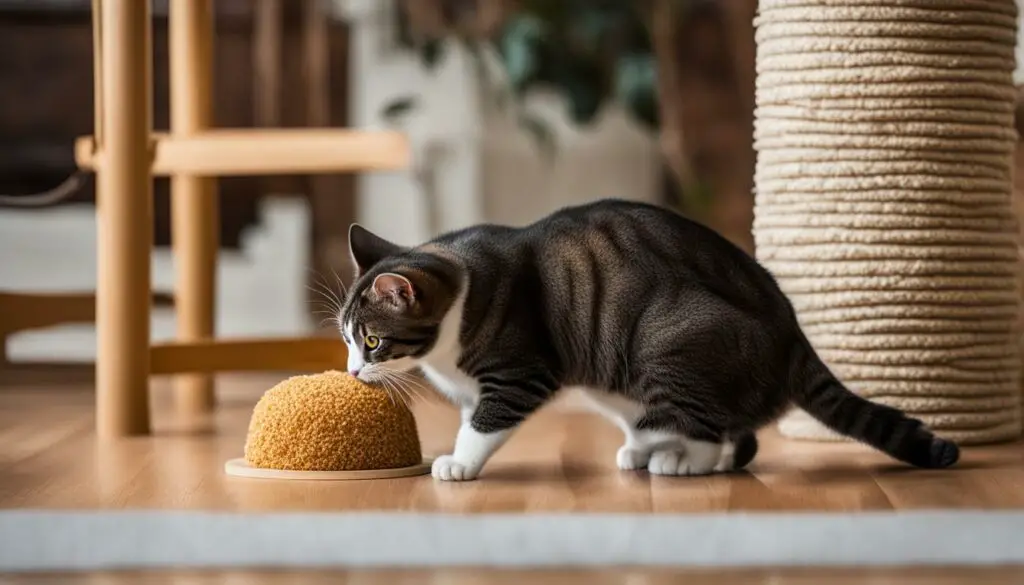
Conclusion
In conclusion, taming an aggressive cat requires understanding their behavior and implementing effective techniques. By recognizing body language, understanding cat motivations, and managing separation anxiety, you can address the underlying causes of aggression.
Creating a safe and comfortable environment, establishing boundaries and communication, and addressing litter box issues are also essential in reducing aggression. Redirecting scratching behavior, training, and socializing an aggressive cat using positive reinforcement can further contribute to a peaceful home.
Remember, patience and consistency are key when dealing with an aggressive cat. With the right approach and the help of a veterinarian or professional cat behaviorist if needed, you can successfully tame your cat and foster a harmonious relationship.
FAQ
How can I tame an aggressive cat?
Taming an aggressive cat requires understanding their behavior, addressing underlying issues, and providing a safe and comfortable environment. By using positive reinforcement training techniques, setting boundaries, and creating a predictable routine, it is possible to tame an aggressive cat and foster a peaceful home. Remember to be patient, consistent, and consult a veterinarian or professional cat behaviorist if needed.
What are the signs of aggression in cats?
Common signs of aggression in cats include hissing, growling, swatting, and lunging. It is essential to be aware of any changes in your cat’s behavior and consult a veterinarian if the aggression persists or becomes a serious issue.
Why do cats display aggressive behavior?
Cats may display aggression due to fear, insecurity, territoriality, or pain. Understanding the underlying cause of aggression is crucial in taming an aggressive cat.
How can I manage separation anxiety in cats?
Managing separation anxiety involves creating a comforting environment for the cat, maintaining a regular schedule, and providing the cat with familiar items that carry the owner’s scent. Behavioral techniques, such as providing distractions and using pheromone diffusers, can also help alleviate separation anxiety.
How do I deal with grief in my cat?
Cats can experience grief and mourning when they lose a companion. Providing extra love and attention, keeping the environment familiar, and giving the cat time to grieve can help them cope with their loss.
How can I help my cat overcome fear of vacuum cleaners?
Desensitizing the cat to the sound of the vacuum can help them overcome their fear. Gradually exposing the cat to the vacuum noise at a low volume and rewarding them with treats can help reduce their fear and aggression.
How can I prevent aggression during playtime?
Understanding appropriate play behavior and avoiding aggressive play can help prevent aggression during playtime. Providing interactive toys and playing in a controlled manner can help redirect the cat’s energy and prevent aggression.
How do I establish boundaries with my cat?
Setting boundaries and establishing clear communication with your cat is crucial in taming aggression. Using consistent positive reinforcement training, setting limits, and rewarding good behavior can help in establishing boundaries and effectively communicating with your cat.
What can I do to create a safe and comfortable environment for my cat?
Providing plenty of hiding spots, vertical spaces, scratching posts, and comfortable resting areas can make your cat feel secure and reduce the likelihood of aggression. Avoiding crowded spaces and providing individual areas for each cat can also help prevent territorial conflicts.
How can I address litter box issues and prevent aggression?
Addressing litter box problems and ensuring a clean and accessible litter box can help prevent aggression related to litter box issues. Providing multiple litter boxes and using unscented litter can also help alleviate litter box problems.
How do I redirect my cat’s scratching behavior?
Providing appropriate scratching posts and regularly trimming your cat’s nails can help redirect their scratching behavior and prevent aggression towards furniture. Positive reinforcement and rewards can also encourage your cat to use appropriate scratching surfaces.
How can I train and socialize an aggressive cat?
Training and socializing an aggressive cat involves patience and consistency. Reward-based training techniques, such as clicker training, can be effective in teaching the cat alternative behaviors and rewarding good behavior. Gradual exposure to positive social interactions and controlled introductions to other animals or people can also help socialize an aggressive cat.
Source Links
- https://be.chewy.com/behavior-pet-body-language-how-to-understand-your-cat-mastering-the-art-of-feline-communication/
- https://www.chirpycats.com/how-to-deal-with-your-high-energy-cat-without-breaking-his-spirit/
- https://www.wikihow.com/Tame-a-Stray-Cat

